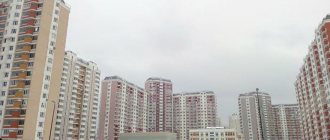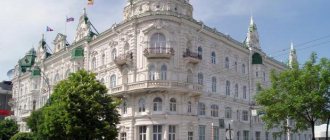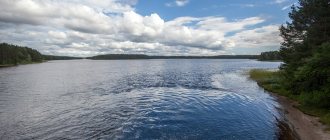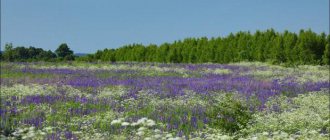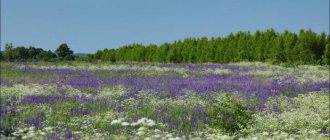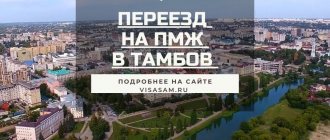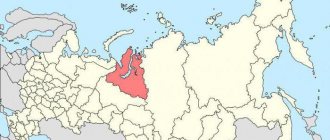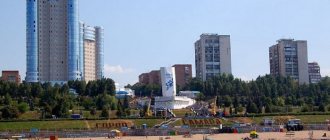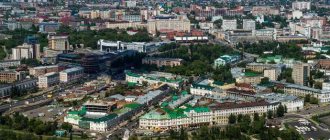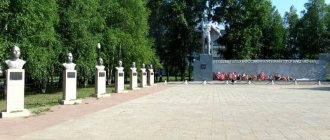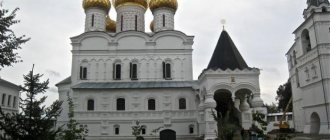Year founded: 1778
The date of the city day is unique for each year.
In 2021,
this date is
September 11
.
In 2021, due to the pandemic, mass events in honor of the city day are canceled or may be postponed
Square named after the 200th anniversary of Kovrov
Kovrov
- Russian city in the Vladimir region, administrative regional center. Located 64 km from Vladimir, on the right bank of the Klyazma River (a tributary of the Oka).
The settlement on the site of the future Kovrov was formed back in the 12th century, it was called the village of Elifanovka, and it was founded by Prince Yuri Dolgoruky. Later the village was renamed the village of Rozhdestvenskoye, by analogy with the Nativity Church built in the village. And in the 16th century, the village of Rozhdestvenskoye was given into the possession of the Kovrov princes, from the Starodubsky family, after which the village began to be called Kovrovo. Kovrov received city status by decree of Catherine II only in 1778
.
In 1916, construction of the Kovrov Machine Gun Plant began in the city; during the Great Patriotic War, it became the main enterprise for the production of automatic weapons for the front.
An old fire station (Photo: wikipedia.org) It was here in 1941 that V.A. Degtyarev created the famous anti-tank rifle. During the entire war, the plant produced more than one million two hundred machine guns, Shpagin submachine guns, anti-tank rifles, and the first Soviet aircraft guns. At the same time, an equipped one was sent to the front. After the war, the plant began producing motorcycles and missiles.
Since 2011, Kovrov has held the honorary title of “City of Military Glory.”
Such famous gunsmiths as V.A. worked in Kovrov. Degtyarev (now there is a House-Museum named after him), G.S. Shpagin, V.G. Fedorov and M.T. Kalashnikov. Among the interesting places in the vicinity of Kovrov is the Klyazminsky town. Previously, it was called Starodub-on-Klyazma and was founded by Yuri Dolgoruky in 1152. During the Time of Troubles, the city was completely destroyed by the Poles. Now only the ramparts and the Church of the Intercession, built in 1803, remain on the site of the town.
At the entrance of the Degtyarev Plant (Photo: wikipedia.org)
In one of the city’s libraries, the Family Reading Library, there has been a hare museum since 1999. It presents more than 700 species of “eared” animals.
But, of course, the most famous landmark of Kovrov is the Transfiguration Cathedral, whose bell tower stands at the top of the descent to the river. The cathedral was built at the end of the 19th century; subsequently it suffered great destruction. Now the cathedral is almost completely restored.
Day of the city
in Kovrov it is celebrated in August or September.
Population
In terms of population, Kovrov ranks second in the region, second only to the regional center Vladimir, which is home to more than 356 thousand people.
Kovrov is located on two banks of the Klyazma River. It’s a stone’s throw from here to Vladimir - 65 kilometers, and it’s not far from Moscow - about 250 kilometers.
City `s history
Kovrov acquired the status of a city in 1778, during the reign of Empress Catherine II. It was she who signed the decree in which she ordered the establishment of the Kovrovsky district, and the village of Kovrovo to be given the status of a district town. This is where the glorious history of the settlement to which our article is dedicated begins.
By 1817 there were almost 900 residents living in 177 houses. Two churches were built at once. The city began to develop at an active pace in 1858, when the construction of the Moscow-Nizhny Novgorod railway began. According to the project, it was supposed to take place about a kilometer from Kovrov. When the railway traffic was launched, it turned out that the first pancake came out lumpy.
A regular train from Nizhny Novgorod, which was carrying out the very first flight to Moscow, crashed just near the Kovrov station. After this, all sorts of shortcomings and shortcomings had to be eliminated within two years.
In 1867, a new disaster happened here. Not far from the Kovrov railway station, two spans of the bridge that was thrown across the Klyazma collapsed into the river, and the water pumping building collapsed. The new bridge was completed in 1871.
Since 1864, railway workshops have been operating in Kovrov, which for quite a long time remained the main place where the male population of Kovrov was employed. In 1880, Kovrov officially became the starting point on the Murom Railway; it was here that the Murom-Kovrov line passed.
Number of inhabitants at the end of the 19th century
By the end of the 19th century, the population of Kovrov was 9,186 people. Most of them were men. In terms of religion, there are almost 9 thousand Orthodox Christians, with schismatics in second place on this list (95 people), as well as very few Catholics, Protestants, Jews and representatives of other religions.
More than six thousand townspeople, more than two thousand peasants, about 400 military personnel, 112 nobles and 43 representatives of the clergy lived in the city. At that time, 770 houses were built in Kovrov. The city developed mainly thanks to the railway. First of all, trade was brisk. There was a lard melting plant, a mechanical weaving factory and a steam flour mill. Many were also employed in machine shops and iron foundries.
One of the most significant enterprises was a paper and weaving factory, owned by merchant Ivan Treumov. It annually produced up to 110 thousand poods of calico. In total, more than one and a half thousand people worked on it. Another interesting fact: there were 33 drinking establishments in the city, as well as two parish and one city school. Now you know what the population of Kovrov was on the eve of the 20th century.
Anthem of the Kovrov region
Kovrovsky district - my life
At early dawn I will get up, washing myself with kindness. Again the worries of the day are coming, sent by fate. A villager will open the window of my soul again; it fell to me to serve the region, and here is my abode.
Chorus:
Live, region, bloom and sing, calm your heart with love, may your whole path be bright, and this is the essence of life.
(2 times)
Here strong people live and are famous for their deeds, Harvesters drive through the fields and extract stone. Malygin craftsmen give bricks to Russia, And the Mayak glassblowers work beautifully.
Chorus.
The Kovrovsky district is my life, I love your open spaces, Here is the Starodub land and Smolino patterns. In Vsegodichi the holy temple is the same age as hoary centuries. I bow to my native land and glorify it in song.
Chorus:
Live, region, bloom and sing, calm your heart with love, may your whole path be bright, and this is the essence of life. Give hope to people, revive holy temples, Let the bells ring from all sides.
Words and music by L. Kurnina.
Development of Kovrov in the 20th century
After the October Revolution, Kovrov retained its reputation as the industrial center of the Vladimir region. In 1929, the railway workshops were reorganized into a mechanical repair plant, which gave new impetus to the development of Kovrov. It produced excavators according to imported drawings.
When the need arose for the production of domestic earth-moving machines, the authorities decided to set up an excavator plant on the basis of the previous workshops. Already in the spring of 1931, the first Kovrovets excavator rolled off the assembly line. Two years later, mass production on an industrial scale began here. In 1966, the Kovrov Excavator Plant, which became popular throughout the Soviet Union, was awarded the Order of Lenin. This was the highest Soviet award that could be awarded to the enterprise.
Another industrial center of Kovrov was the machine gun factory, which began to be built back in 1916. After the October Revolution, famous designers of that time - Degtyarev and Fedorov - were sent here to launch the production of firearms. The stable operation of the plant played an important role in the success of the Red Army in the Civil War.
Kovrov
Kovrov, the City of Military Glory, is the administrative center of the Kovrov district and the second (after Vladimir) city in the Vladimir region by population - 138,552 people (2017). Kovrov is located on both banks of the Klyazma River, 64 km northeast of Vladimir. The city is a major railway junction on the Moscow (250 km to Kovrov) – Nizhny Novgorod highway, and has access to the M-7 Volga highway.
Story
Although Kovrov received city status only about 240 years ago, its age is much more respectable. According to legend, in 1157, the Vladimir prince Andrei Bogolyubsky, returning in winter from Suzdal to Starodub (now the village of Klyazminsky Gorodok, Kovrov district), got lost in the local forests and accidentally came to the hut of the trapper Elifan. In honor of the miraculous salvation of the prince at Christmas, the wooden Church of the Nativity of Christ was cut down on the high Klyazma bank. Based on the name of this temple, the village of Elifanovka located here began to be called the village of Rozhdestvenskoye. In the 13th century. The village became part of the Starodub principality.
From the end of the 15th century. Rozhdestvenskoye passes into the possession of the Starodubsky-Kovrov princes. The nickname of the princely family of Starodubsky “Carpets”, according to legend, appeared with the light hand of Prince Dmitry Donskoy after during the Battle of Kulikovo in 1380 A.F. Starodubsky carried the Khan's expensive carpet out of the enemy camp. It was this princely nickname that gave the new name to the Rozhdestvensky village - Kovrovo.
In 1567, the village of Kovrovo was donated by Prince I.S. Kovrov to the Suzdal Spaso-Evfimiev Monastery ,
and was in his patrimony for more than two centuries - until 1774. The area around the village was rich in limestone deposits, the development of which has long been one of the main occupations of the Kovrov residents. In particular, the buildings of the Spaso-Evfimiev and Pokrovsky monasteries in Suzdal were erected from Kovrov white stone.
The village of Kovrovo had a fairly advantageous location on the banks of the navigable Klyazma River. In this place there was a constant transport through Klyazma on the busy Nizhny Novgorod trade route. A trade transhipment pier was created near the village of Kovrovo, where bread, fish, salt and other products, forest materials, and handicrafts were brought from everywhere.
All this contributed to the acquisition of urban status by the village of Kovrov. On September 1, 1778, Empress Catherine II signed a decree establishing the district town of Kovrov in the Vladimir governorship. In 1781, it already had its own coat of arms as a city privilege. There is a legend that the Tsar's governor, Count Vorontsov, was very fond of hunting hares in the Kovrov forests. It was he who proposed to depict these animals on the Kovrov coat of arms next to the emblem of Vladimir - the lion.
Until the middle of the 19th century. Kovrov was a quiet provincial town. The industrial and commercial development of the city was facilitated by the construction of the Nizhny Novgorod railway, traffic on which was opened in 1862. At the same time, central railway workshops appeared in Kovrov, which became famous in Russia. Here, freight and passenger cars were created, which were awarded at the end of the 19th century. highest awards at industrial exhibitions in Moscow and St. Petersburg. In addition, the first ambulance trains were produced in the Kovrov workshops. During the First World War, Kovrov was one of the formation points for military ambulance trains, each of which could receive up to 400 wounded. In 1929, the railway workshops were repurposed into a mechanical repair plant, which carried out orders for the repair of imported excavators, and in 1931 - into the Kovrov Excavator Plant, which became the first manufacturer of domestic Kovrovets excavators.
By the beginning of the 20th century. Kovrov had already become a major industrial center of the Vladimir province with a population of 14,571 people (according to the results of the first All-Russian census of 1897). Along with the railway workshops, a large steam-powered calico and weaving factory of the merchant I.A. operated in the city. Treumova, an iron foundry, numerous brick factories, a steam mill, a sawmill.
In 1916, construction began on the Kovrov Machine Gun Plant. The real development of the plant since 1918 was associated with the activities of the outstanding scientist V.G. Fedorov, the inventor of the world's first assault rifle, and the outstanding designer of automatic weapons V.A. Degtyarev, who headed the plant’s design bureau until his death in 1949. There is a memorial house-museum of V.A. in Kovrov. Degtyarev, whose exhibition tells about his life and design activities. In 1949, the plant received a new name - Plant named after. V.A. Degtyarev (today it produces not only defense, but also civilian products, for example, motorcycles). During the Great Patriotic War, the plant became the country's main enterprise for the production of anti-tank and other types of weapons for the front.
Carpets during the Great Patriotic War
It is difficult to overestimate Kovrov's contribution to the Great Victory. 13 Heroes of the Soviet Union brought glory to the city (L.V. Lopatin, I.S. Nosov, V.A. Burmatov, I.V. Pershutov, F.G. Konkov, V.I. Yastrebtsov, A.P. Generalov, P.K. Rangev, V.G. Kabanov, P.S. Mashtakov, V.A. Zaevsky, A.P. Martynov, G.V. Provanov). All large enterprises of Kovrov were reoriented towards military production. There were many hospitals in the city, since it was located in the rear near the front line. In November 2011, by decree of the President of the Russian Federation, Kovrov was awarded the honorary title “City of Military Glory.” In November 2013, on the square in front of the central entrance of JSC Plant named after V.A. Degtyarev" stele "City of Military Glory" was installed.
In 2012, in connection with the awarding of this title to Kovrov, it was decided to adjust the coat of arms taking into account the recommendations of the Heraldic Council under the President of the Russian Federation. Instead of a red ribbon, the coat of arms is now surrounded by a white and blue order ribbon - a sign that in 1978 Kovrov was awarded the Order of the Red Banner of Labor. The golden tower crown with five teeth is an indicator of the status of the urban district. The swords crossed behind the crown symbolize the title “City of Military Glory” awarded to Kovrov.
Economy
Modern Kovrov is a large industrial and scientific center of Russia, primarily in the defense industry, mechanical engineering and metalworking. Enterprises in these industries create over 70% of the city’s total industrial output and employ about 40% of the city’s working population.
OJSC "Plant named after Degtyarev" (ZiD) today is a diversified enterprise that produces not only defense products (small arms, anti-tank and missile weapons), but also motor vehicles (motorcycles, motorized towing vehicles, scooters), soil-cultivating equipment, food industry equipment, LED lamps. PJSC Kovrov Mechanical Plant (KEP) is one of the leading enterprises in the Russian nuclear industry, since 2007 specializing in the manufacture of high-tech and technically complex products - gas centrifuges (devices for separating uranium isotopes). The main specialization of OJSC Kovrov Electromechanical Plant (KEMZ) is hydraulic equipment, and the plant also produces multifunctional mobile robotic systems, used, in particular, for searching and remotely neutralizing explosive devices. In 2021, KEMZ began production of a new model range of Zetor Forterra (“ANT 4135F”) tractors as part of the import substitution program. VNII "Signal" is engaged in the development and production of defense hydraulics and electronics. Design Bureau "Armatura", since 1997 part of the State Space Research and Production Center named after. M.V. Khrunichev, works in the field of development and manufacturing of units and systems of ground infrastructure of rocket and space complexes, as well as pneumatic hydraulic systems of launch vehicles.
Among the light industry enterprises in Kovrov there are such well-known in Russia, producing men's suits, "Ascona" - the largest manufacturer of orthopedic mattresses, etc. In the 1990s, the ancient pottery craft was revived, in 1993 the Kovrov Clay Toy factory was founded, received the status of folk art.
Famous people
The names of many famous people of Russia are associated with the city of Kovrov. Famous gunsmith designers V.A. lived and worked here. Degtyarev (1879/1880-1949), V.G. Fedorov (1874-1966), G.S. Shpagin (1897-1952). A native of Kovrov was I.M. Yatsunsky (1916-1983), Soviet scientist, one of the creators of the first artificial Earth satellite, is recognized as the founder of space geodesy. Born in Kovrov: A.M. Kolesov (1834-1902), Russian portrait painter; S.K. Nikitin (1926-1973), famous Soviet writer; A.P. Nepomniachtchi (1968-2007), popular bard, rock musician, etc.
Sports resort Dobrograd
Today, of interest to tourists and guests of Kovrov is the Dobrograd sports resort, which is located on the territory of one of the first private cities in Russia and is a unique object of public-private partnership. In September 2021, the VI International Sports Forum “Russia – a Sports Power” was held in Dobrograd.
Author: V. Korolkova
During the Great Patriotic War
During the war against the Nazi invaders, almost 8 thousand Kovrov residents enlisted in the ranks of the voluntary people's militia. Two rifle regiments, an artillery division, three fighter battalions, and a cavalry brigade were formed. The latter was commanded by Major General Pyotr Rudchuk.
The former machine gun factory became the main enterprise for the production of automatic weapons for the front. In 1941, small arms designer Vasily Degtyarev created the famous anti-tank rifle. During the war years, more than a million units of various weapons were produced and sent to the army, including Shpagin submachine guns, aircraft guns, and anti-tank rifles. The Kovrov plant again played a decisive role in supplying the army with weapons.
After the war, motorcycle production was opened in Kovrov, and the Degtyarev arms factory began producing missile weapons.
In 1949, another large industrial enterprise was founded here - a garment factory. Since 1968, intensive housing construction began, which is carried out by Kovrovstroy. Construction began on the southern part of the city. In 1970, a reinforced concrete bridge was put into operation, and five years later a trolleybus service was launched.
Population dynamics
The first data on the population of Kovrov dates back to 1784. At that time, only 581 people lived here. After Empress Catherine II signed the corresponding decree conferring the status of the city, its population began to grow systematically. Already in 1856, the population of Kovrov was 2,200 people. By 1870 it had increased to 4.9 thousand, and in 1895 it exceeded five thousand inhabitants.
Just two years after this, the population of the city of Kovrov, Vladimir region, almost doubled and amounted to 14.5 thousand people.
In the landmark year 1913 for the Russian Empire, 18,200 people lived in Kovrov. After the October Revolution, the population of Kovrov initially decreases slightly, but very quickly recovers and even goes up. By 1931, 41 thousand people settled here.
Before the Great Patriotic War, the population of Kovrov was more than 67 thousand people. After the victory over fascism, they began to actively build and open new industrial enterprises here, which required workers. Therefore, the positive dynamics continued. Already in 1962, the population of the city of Kovrov, Vladimir region, exceeded the mark of 100 thousand. In 1970, over 123 thousand people lived here, and in 1973 - exactly 130,000.
The population of Kovrov surpassed the psychological mark of 150 thousand people in 1985. This figure reached its highest level in 1990. At that time, the population of the city of Kovrov was 162 thousand people. There have never been so many people here before.
After this, a decline began, which was noted throughout the country. It was caused by the collapse of the Soviet Union and perestroika. Due to economic reforms and a sharp transition from a planned economy to a market economy, the country found itself in a deep crisis. Enterprises did not pay salaries, people left small towns for large cities, everyone tried to earn money and survive as best they could. Next to Kovrov was Moscow, where many residents flocked.
The systematic decline in the population of the city of Kovrov continued throughout the 90s, and it did not stop in the 2000s, when the situation in the country as a whole began to improve. People are still leaving Kovrov; there remains a high mortality rate and a low birth rate. The demographic decline has not yet been stopped. If in 2021 there were 139,280 people living in the city, then in 2017, as you already know, there were 138,552 people. It is still unknown about any decisions by the authorities that can correct the situation. This is how many people currently live in Kovrov.
Ethnic interior styles
This style is chosen by versatile, spiritually rich people, most often creative individuals. This interior is distinguished by the presence of elements characteristic of certain nationalities or cultures.
The most common directions:
Japanese. The modern style serves as the basis, it is complemented by the absence of armchairs and even chairs, red elements, a contrasting combination of white and black, and decorative elements with hieroglyphs.
Egyptian. Characteristic are specific ornaments, all shades of white and sand, a combination of gold and black. Accessories in green and blue shades are acceptable.
Indian. Characterized by simple shapes, the color range is represented by rich yellow, red and brown colors.
African. Modern style, complemented by African culture motifs. Dark brown shades of wood, yellow and beige, black leather, splashes of terracotta, green, blue, red, and less often blue accessories.
In these directions, a round carpet on the floor with a rough texture, plain products with long or medium pile will look good. Imitation of wild animal skins can be used, and in the Japanese style - small decorative mats of rectangular or square shape.
Now you know how to choose a carpet for the floor, and you can effortlessly transform any room.
National composition
The national composition of the residents of Kovrov is practically no different from the situation in the Vladimir region and throughout Central Russia in general.
At the moment, almost 90 percent of the residents of Kovrov are Russian. All other nationalities are represented in negligibly small numbers. It is worth saying that no other nation has gained even one percent of the inhabitants among the entire population of Kovrov, so there are no strong and large diasporas here.
In fact, Ukrainians have second place in this ranking: they are 0.87%, which is about 12 and a half thousand. The top three are completed by the Tatars, who make up about half a percent of the total population.
Among the peoples of whom more than one thousand people live in Kovrov, there are also Armenians, Belarusians, Uzbeks, Azerbaijanis, Gypsies, Mordovians, Moldovans, Tajiks, Chuvashs and Germans.
According to the latest data, 927 Georgians live in the region, even fewer Mari, Udmurts, Bashkirs, Kyrgyz, Lezgins, Koreans, Jews, Avars, Kazakhs, Dargins, Poles, Chechens, Turkmen, and Greeks. There are 253 Ossetians living in Kovrov - this is the smallest nation, if we take into account those who indicated their nationality.
Coat of arms
The coat of arms of Kovrov is presented in the form of a French shield. In a green field there are 2 silver hares, sitting on their hind legs and facing away from each other. In the upper left corner is the coat of arms of the Vladimir region.
The shield is crowned with a tower crown with five teeth, behind which two swords are placed crosswise. It is surrounded by a white and blue ribbon of the Red Banner of Labor. She points to the award being given in 1978.
The artistic composition is included in the State Heraldic Register of the Russian Federation under No. 7566. Adopted by decision of the Council of People's Deputies of the city No. 24 of January 25, 2012.
Transport development
Knowing how much population there is in Kovrov, it is important to understand the development of transport routes. The main railway from Nizhny Novgorod to Moscow still passes through the city. So it is an important railway transport hub. Trains go from here to Perm, Kirov, Siberia and the Urals.
In 2003, a new railway station was opened in Kovrov. It was a large-scale and very protracted project, which began to be implemented in 1991. Its capacity is 900 passengers, which allows the station to be classified as second class. In total, 70 million rubles were spent on its construction.
Two years later, the second stage of the station was commissioned, into which the bus station, previously located in a building dating back to the 19th century, moved.
The Moscow-Nizhny Novgorod federal highway, known as M7, passes through the city. Many regional routes. A few decades ago, navigation was carried out along the Klyazma, but now it is impossible due to the severe shallowing of the river bed.
Choosing a floor carpet for various types of interior
This product will be an ideal addition and decoration to any interior. Read below about how to choose a carpet for the most popular styles.
Classics in interior design
Classic room design is the choice of serious, conservative and emotionally restrained people. Versatility and strict forms are characteristic of this style. Has several subtypes.
Classicism. Strict symmetry, expensive materials are used for finishing, the color scheme is chosen harmoniously.
Gothic style. There are stained glass windows, elements whose shapes are elongated and pointed, and an antique metal finish is used.
Baroque style. It is distinguished by a combination of expensive materials, luxurious textures and details, the presence of columns, and volume. Antiques, mirrors and paintings from this era are used as decor.
Greek style. The furniture is simple, light, made of carved wood. The color scheme is pastel colors, but it is possible to use accents: objects in blue, green, and dark blue shades. Frescoes, sculptures of various sizes, and large floor vases are used as decorations.
Renaissance. The interior uses expensive antique-style furniture, an abundance of marble, harmony and softness of colors.
Modern. It is characterized by the presence of shades of wood, natural stone, romance, soft and curved lines, and asymmetrical elements.
When choosing a carpet for the floor in a living room or other room made in a classic style, prefer an expensive handmade Persian carpet, the shades of which should ideally complement the color scheme. The exception is Art Nouveau, in which it is permissible to use carpets in the form of wild animal skins.
Economy of the city
Industry occupies a key place in the development of the economy of Kovrov. Federal transport also plays an important role, represented here by several major highways. The regional budget largely depends on the federal center. The share of financing from the budget of the Russian Federation is at least 25 percent.
Agriculture accounts for 9 percent of the gross regional product. Recently, regional authorities have been striving to actively develop eco-tourism and excursion tourism.
The city itself is traditionally considered a major industrial and defense center. Its main representative, where the majority of the population works, is the Degtyarev plant. Now it produces not only missiles and small arms, but also motorcycles, mopeds, batteries, even sewing machines.
An important place in the city’s economy is occupied by the Kovrov Mechanical Plant, which stopped producing small arms in 2006. Now welding machines, solar panels, and gas centrifuges are produced here. Equipment for nuclear power plants, which is rarely produced anywhere else, is in particular demand.
The electromechanical plant specializes in defense robotics, and the Signal enterprise produces and develops electronics and hydraulics for the domestic defense complex.
The Armatura design bureau produces and develops weapons and space technology, and the instrument-making plant produces door locks and car filters.
Until recently, one of the largest excavator plants remained; there is even a monument to the excavator in the city. But in 2009, production was completely frozen, and the equipment was transported to a similar enterprise in Tver.
established, together with Austrian entrepreneurs, the joint production of modular buildings and modular containers.
All these enterprises provide more than 70 percent of the total volume of industrial products produced in the city. Up to 40 percent of residents are employed in these industries.
Light industry
Light industry is developed in Kovrov and the sector produces popular consumer goods from plastic - snow shovels, garden equipment, skis, ice skates, snow scooters and mailboxes. The Vladimir Door Factory is one of the largest in the region for the production and production of interior doors, offering the best prices on the local market.
Nikos LLC produces cotton fabrics and produces men's suits. The commercial equipment plant in Kovrov has launched the production of automation systems, and the Trimo-VSK enterprise produces roofing and wall sandwich panels.
It was in Kovrov that the PIK research and production corporation opened a large production of mattresses and specializes in several areas of the economy - construction, hotel business, production of bread and meat products, design services, and securities transactions.
The Kovrov Electrotechnical Plant produces electrical equipment, primarily panels, cabinets and panels. CJSC Proton has launched the production of access control and management systems, as well as the production of economical lighting devices, the design of which is based on diodes.
There is also a clay toy factory in this city, which develops a traditional craft that was widespread in ancient times in this region. occupied a niche in the production of bathtubs, sanitary ware, spa pools and showers.
These enterprises employ a significant part of the residents of Kovrov.
Population of Kovrov: size and ethnic composition on News4Auto.ru.
Our life consists of everyday little things that in one way or another affect our well-being, mood and productivity. I didn’t get enough sleep - my head hurts; I drank coffee to improve the situation and cheer myself up - I became irritable. I really want to foresee everything, but I just can’t. Moreover, everyone around, as usual, gives advice: gluten in bread - don’t go near it, it will kill you; A chocolate bar in your pocket is a direct path to tooth loss. We collect the most popular questions about health, nutrition, diseases and give answers to them that will allow you to better understand what is good for your health.

